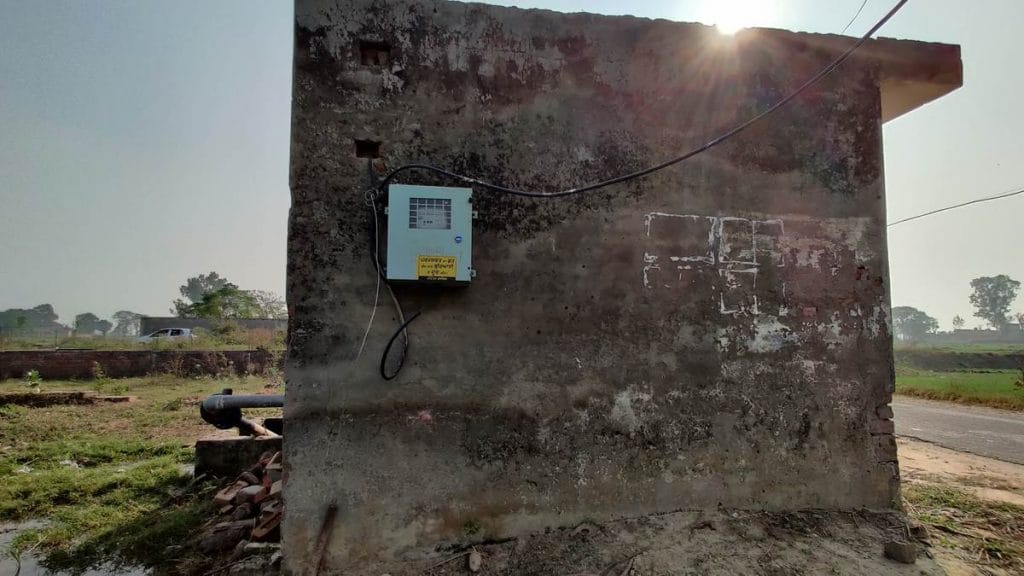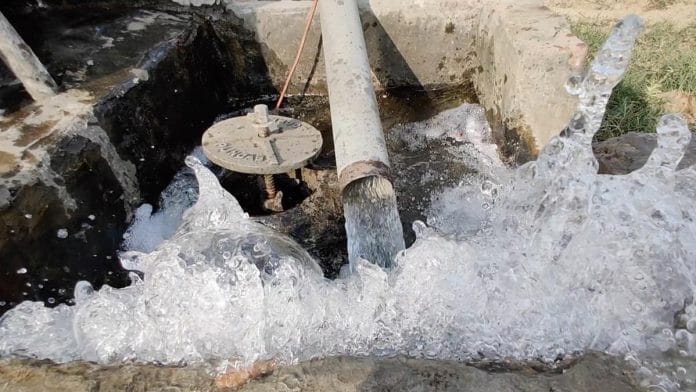Jalandhar: Jagdish Singh of Bambianwal, in Jalandhar district, has been reducing the use of water in his six-acre farm every year. He diligently notes down how much water his farm really needs, purely at an observational level. Since 2018, he says, he has been using significantly less water than he did earlier.
The change in practice, Jagdish says, began after he became a subscriber to the Punjab government’s 2018 scheme ‘Pani Bachao Paise Kamao’ (save water, earn money). The motive behind the scheme is to incentivise farmers to use less electricity and, in turn, less water for irrigation by paying them for every unit of electricity they save at a rate of Rs 4 per unit.
The scheme is vital because Punjab’s water table is depleting at an alarming rate of 47 cm per year. Groundwater usage is at a glaring 165 per cent of the recharge rate — the rate at which surface water percolates underground — in the state, so the scheme aims to promote judicious water usage and crop diversification.
“We have separate feeders for agriculture that we monitor. Earlier, there was a lot of wastage because farmers used to leave their motors running, so through this scheme, we’ve incentivised them to save electricity and hence water,” said a source in the Punjab State Power Corporation Limited (PSPCL), the implementing agency for the scheme. The farmers enrolled under this scheme also get two hours of extra supply of electricity during the day.
However, enrolment in the scheme stands at just 4.69 per cent of all electricity consumers in the 12 districts — in all, 2,430 consumers across 200 villages — where the scheme has been introduced. Farmers like Jagdish also complain that they haven’t received the promised benefits in the past one year. Awareness of the scheme among farmers is also patchy.

Venu Prasad, chairman and managing director of PSPCL, told ThePrint that some subsidies are pending. “But we’re in the process of clearing them as soon as possible,” he said, adding that the Covid pandemic, not the farmer protests, have impeded the enrolment process.
“This scheme is voluntary, so farmer protests haven’t caused an issue in enrolment. It’s just because of Covid that our ground workers haven’t been able to reach the farmers,” Prasad said.
Asked about the lack of crop diversification on the ground, the chairman said the PSPCL’s objective is to encourage farmers to move away from rice and wheat cultivation.
“When we’re unable to convince farmers to diversify their crop, we inform them on how to cultivate existing crop using less water. The agriculture department holds meetings in villages for the same,” he added.
Chief Minister Charanjit Singh Channi himself holds the power portfolio, under whose ambit the scheme is run. An email sent to the CMO through an official Saturday, seeking comment, did not elicit a response.
Also read: MSP, subsidies are at root of Punjab’s farm crises but its farmers are fighting to keep them
How the scheme works
Under the ‘Pani Bachao Paise Kamao’ scheme, a separate meter is installed on the tubewell of every subscriber, and the number of units for consumption is fixed according to the capacity of the tubewell.
Separate units are fixed for the Rabi and Kharif seasons. When a farmer saves electricity from his fixed quota he’s paid Rs 4 a unit as subsidy. So, if a farmer’s fixed quota is 100 units and he uses only 90 units, then he gets a benefit of Rs 40 for the 10 units saved. The subsidy reaches subscribers’ accounts through a direct benefit transfer.
However, the benefit isn’t enough to dissuade people from cultivating wheat and paddy, which are water-intensive crops. For example, while Jagdish is more mindful about his water usage, he has not shifted to cultivating crops other than paddy.
“If I cultivate any other crop, the price realisation will be poor. MSP is available only on wheat and rice, so why will I cultivate anything else? There’s also price volatility in other crops. Who knows, if there’s an excess supply of potato this season, I’ll only get paid Rs 10 a kg for it,” he said.
Farmers also told ThePrint that they get anywhere between Rs 2,000 to Rs 5,000 benefit on a monthly basis, depending upon the number of units they save. The benefit, though, hasn’t reached them in the past six months to one year.
“I haven’t received any money in the past six months. The meter they installed has malfunctioned, and even after complaining, nobody has come to check up on it,” said Taranjit Singh, a farmer from Kukar village.
Unlike Jagdish, Taranjit said he hasn’t been so conscious about saving water. He said giving more subsidies won’t work, but billing farmers for electricity just might. “Charge us for using our motors. When fat bills start reaching farmers, we’ll automatically consume electricity in a more rational way. As long as wheat and rice are the only crops on which we get guaranteed MSP, nobody is going to stop cultivating them,” he said.
Low enrolment, lack of awareness
The reasons why enrolment under the scheme remains low at 4.69 per cent are the lack concern about saving water, of awareness, and low subsidy.
A PSPCL official said that due to the Covid pandemic and farmer protests, progress in the Paani Bachao Paise Kamao scheme has been stalled, as fewer ground level workers have been able to interact with farmers during this time. PSPCL workers have also been on strike, which started in June and is in its second phase now.
Raghuveer Singh, who farms on leased land in Bambianwal village, says he hasn’t subscribed to the scheme because it wouldn’t help him at all. “I have leased 12 acres of land from zamindars who don’t live in the village any longer. Because I have a big piece of land to look after, subscribing to this scheme makes no sense, since I am unable to save electricity,” he told ThePrint. “For a Rs 1,500-Rs 2,000 a month benefit in my account at the most, why will I go through so much headache?” he asks.
In Sangrur and Patiala districts, ThePrint also found a lack of awareness about the existence of the scheme. In Daun Kalan and Shankerpur villages in Patiala and Ubbawal village in Sangrur, even the sarpanches were clueless about its existence.
“Nobody from the bijli board has come here to inform us of any such scheme, which sounds like a good scheme that would benefit the farmer. We would have definitely subscribed to the scheme had we known about it,” said Baldev Singh, sarpanch of Ubbawal.
Also read: From debt to unemployment, Punjab’s entire economy needs reform, not just agriculture
Growth of scheme
The scheme was launched in Jalandhar, Hoshiarpur and Fatehgarh Sahib districts in Punjab’s Doaba and Malwa region in 2018 as a pilot project.
According to data accessed by ThePrint via the source in the PSPCL mentioned above, the scheme now has subscribers from 12 districts across the three regions of Punjab. According to this data, the total enrolled percentage is only 4.69 per cent of the PSPCL’s total consumers base in the districts.
The scheme started on six power feeders (power lines through which electricity is transmitted to the distribution points), but is now available on 259 of the state’s 5,900 rural power feeders. “We have approximately one agricultural pump feeder for every village in the state, which means approximately 200 villages have been covered under the scheme,” the source added.
As of October 2021, a total of 2,430 consumers are part of the scheme. The total number of subscribers in September 2020 was 2,091, which means that only 339 farmers have joined the scheme this year.
There was no data on the payments made between February and June 2021, in line with farmers claiming that they haven’t received any benefits this year.
Massive power savings
The positive aspect of the scheme is that power savings have greatly increased. Between June 2018 and February 2019, farmers received Rs 8.65 lakh in subsidy and saved 2.16 lakh units of power. Between February 2019 and February 2020, Rs 43 lakh were received in subsidy and 10.98 lakh units of electricity were saved. In the same period in 2020-21, Rs 19 crore were given in subsidy, while 49 lakh units of power was saved. Between February and June of this year (the last for which data is available) total payable subsidy was Rs 20 lakh, while 5 lakh units of electricity were saved.
While the total subsidy amount payable since 20 June 2018 is around Rs 2 crore 74 lakh, the total benefit transferred to consumer accounts is only Rs 2 crore 32 lakh. A subsidy amount of Rs 42 lakh is still to be paid out.
(Edited by Saikat Niyogi)
Also read: How Bihar recorded growth but Punjab lagged behind and why farm reforms are important






